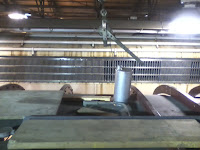This week I went out to the Museum on Sunday afternoon, mainly so I could meet up with Bob Sundelin to work on the 309 bearing project. I bought the hose clamps he had recommended and clamped the two halves of the bearing together as a test. So far so good.
Bob had been able to look inside the big oven when it arrived, and as he remembered it there was no actual floor in the oven compartment that you could support something on. So we agreed we really needed to look at it in more detail. Typical IRM problem: in order to open the door to the oven, we need to move the welder. And in order to move the welder, we need to move the forklift. Luckily Gregg W. was there, and helpfully ran the forklift out of the way for us. Thanks!
Bob was right: the bottom of the heating chamber is where the hot air is blown in, so it's not designed to support anything. Instead, there are channels on each side for supporting shelves or brackets.
I guess you could also hang slabs of beef from the ceiling, but maybe some other time....
This is an all-purpose oven. I have to agree:
But I have a question: the builder's plate says "Oven designed for .8 QT solvent". What solvent? If you think you know the answer, and are not just making a wild guess, I'd like to hear about it.
Next, I spent some time finding the metal we'd need out underneath a boxcar, then making two brackets of the right length to support the pipe frame seen above. The brackets can be clamped to the supports inside the oven so that the pipe frame can't move, and all should be well.
Bob spent most of the rest of the day turning down trolley wheels. He's very good at meticulous work like this.
And I continued on the inspection process by testing out the brake system on the 319. It works well, but there seem to be some very slow stem leaks on both brake valves (M23), so those should be looked at when possible. The valves themselves are easy to remove without breaking any joints.
But perhaps the most interesting project was putting ceiling panels back into the Electroliner. As Ed Oslowski says, they're really turned a corner when you start putting it all back together. Here Kevin and John Arroyo are hard at work drilling the needed holes:
And they seem to be having a good time, or at least until John noticed me:
Meanwhile, Donna and Ed are taking a break to admire the progress:
And getting the panels into the right curve to fit the carlines is not easy. I can vaguely remember doing something similar about forty years ago, but I failed to take pictures of myself in the process. Be that as it may, it's much more relaxing to watch other people trying to meet the challenge.
And when they're done, it looks great:
And by the end of the day, one side was complete, and they're ready to start on the other side.
Meanwhile, the inspection process continues with the younger guys -- Thomas, Greg, Nick, and Brian -- working on the singles, 22 and 41.
That's all I had time to take pictures of today. But when the news breaks out, Hicks Car Works will break in, unless we're doing something else.


































































